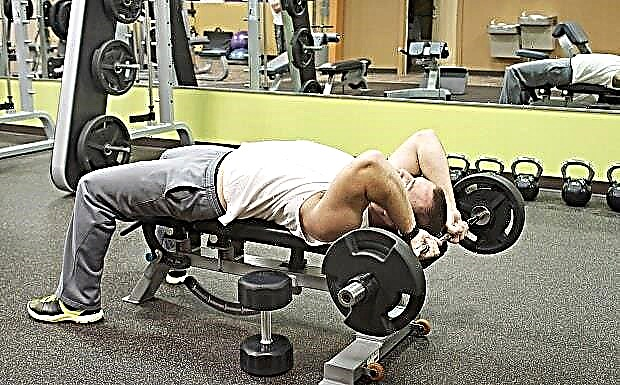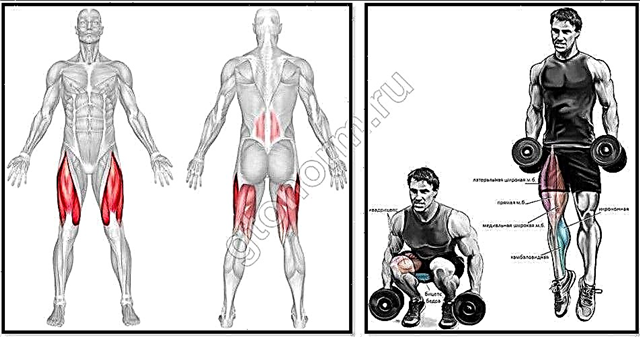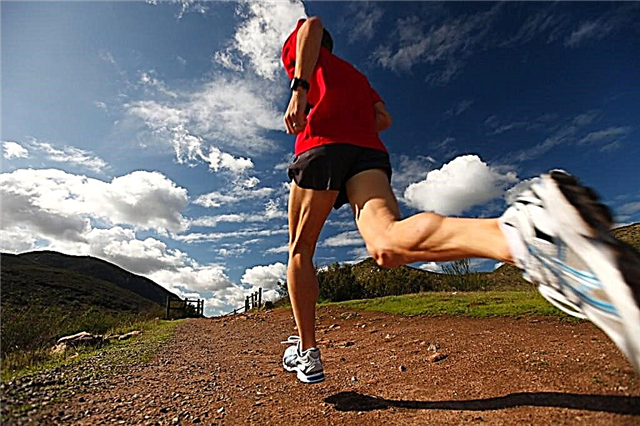Among all the exercises that we perform for the development of the triceps, the French bench press is of particular value to us. This exercise, along with push-ups on the uneven bars and bench press with a narrow grip, is a kind of foundation, without which it is impossible to build a truly strong and massive triceps.
There are many variations of this exercise: lying down, standing, sitting, with a barbell, with dumbbells, on a block ... Today we will focus on the two most common options: French lying with a barbell on a horizontal and incline bench, since all other methods have no fundamental difference from the point of view of technology, and if you have mastered the option proposed in the article, then there should not be any difficulties with the rest of the varieties of this exercise. Well, let's figure out together how to do the French bench press correctly, what muscles work with this exercise, common mistakes and alternatives for replacement.
Also in our today's article, we will sort out the following points:
- Exercise technique;
- Typical mistakes of beginners;
- What can replace this exercise.
What muscles does the French barbell press load?
The French bench press is the exercise that puts the greatest stress on the long bundle of our triceps, which, for most athletes, is the hardest to respond to strength training. It's all about the correct range of motion: here we can stretch and shorten the long head of the triceps as much as possible. For the greatest stretch of the triceps in the negative phase of the movement, some athletes perform this exercise with a barbell or with a dumbbell on an incline bench at an angle of 30-45 degrees. The lateral and medial triceps bundles also receive a sufficient share of the load, due to which there is a colossal leap in the development of the muscles of the arms.

© Makatserchyk - stock.adobe.com
In addition to triceps, the front bundles of the deltoid muscles and the muscles of the forearms are actively involved in the work. The muscles of the core are responsible for stabilizing our body, so they also carry a small static load.
Correct technique for performing the French press
Not only the volume and strength of your muscles depends on how accurately you follow the correct technique for performing the French bench press, but also the condition of the joints and ligaments that work when performing the movement. The French press is just one of those exercises where there is only one factor, giving due attention to, you will certainly achieve success - technique.
Now attention: most of the gym goers have no idea how to do the French bench press with a barbell correctly. There are a lot of mistakes: from the position of the elbows to the position of the feet.
The French barbell bench press is the exercise that puts the greatest stress on the long head of our triceps, which tends to be the hardest to train.
It's all about the correct range of motion: here we can stretch and shorten the long head of the triceps as much as possible. For the greatest stretch, some athletes perform this exercise on an incline bench at an angle of 30-45 degrees. The lateral and medial triceps bundles also receive a sufficient share of the load, due to which there is a colossal leap in the development of the muscles of the arms.
Initial position
- First, place the barbell at the head of the bench at a comfortable level for you or ask your training partner to move it to you.
- Bend your elbows, gently grab the bar with your palms at a symmetrical distance from the center and lift it up, fully straightening your elbows. This is our starting position. The width of the grip depends on which bar you are working with, so in order to diversify the load, I recommend changing the bar from workout to workout: straight, EZ- or W-shaped, they are all great for the French press.

© lawcain - stock.adobe.com
Barbell bench press
- Smoothly begin to lower the bar down, while taking a smooth breath. There are two opinions as to where the projectile should be lowered: behind the head or to the forehead. I believe that it is more expedient to lower the bar behind the head, as if trying to put it back on the bench, as we increase the range of motion and emphasize the load more on the long head of the triceps. However, it should be understood that this is not the most convenient exercise from the point of view of biomechanics, and in it one should not strive for huge working weights and neglect the warm-up, take my word for it, injuring the elbow joints and ligaments on the French bench press is a trifling matter.

© lawcain - stock.adobe.com
- Once you have lowered the barbell low enough and properly stretched the long triceps head, begin to squeeze the bar up to its original position, making a powerful exhalation. In this case, the elbows should be in the same position as when lowering, it is unacceptable to spread them out to the sides or bring them inward, and the buttocks, upper back and nape should be pressed tightly against the bench. After you have returned to the starting position, repeat the movement.
If you want to make the task more difficult, try the French Incline Barbell Press. Seek help from a friend in the gym so that he can give you a barbell, it is not very convenient to throw it yourself.
The biomechanics of the French press on the horizontal and incline bench are the same, but a slight incline gives us the opportunity to stretch the triceps even more (and even more load the elbow joints and ligaments, remember this too).

For this reason, you should not approach the French incline press with too much zeal and fanaticism, the weights should be moderate, and the technique should not be changed. When doing the French press with a barbell on an incline bench, you can slightly lift the back of your head from the bench and bring the barbell behind your head - this will add a few precious centimeters to the amplitude of the press and stretch the long triceps head even more.
Common beginner mistakes
This is terribly unfair, but often the more effective the exercise, the more traumatic it is. The French press in this matter is no exception. Therefore, I highly recommend that you familiarize yourself with the technical errors listed below and try never to repeat them.
The elbows should be at the same level throughout the entire set. Try to keep them still, any movement to the side (especially inward) greatly increases the risk of injury. To avoid this, start doing the French bench press with minimal weights, mentally concentrating as much as possible not only on stretching and contracting the triceps, but also on the position of the elbows.

Don't reinvent the wheel. I have repeatedly seen in the gym the following picture - the athlete puts his feet on the bench during the approach of the French press, there is absolutely no sense in this, the load on the muscles does not change at all, and it becomes much more difficult to maintain a stable position on the bench.

Don't throw your head back. Often, many novice athletes throw their heads back down (below the level of the horizontal bench) during the French press, ostensibly in order to better stretch the triceps. In fact, there is absolutely no difference where your head will be located, since the amplitude will be the same in both cases. But if you lower your head down, your intracranial pressure rises, which we do not need at all during strength training.

Pay attention to your warm-up. You should not even begin this exercise without properly stretching your elbows, shoulders and hands. Neglecting the warm-up, sooner or later you will definitely get injured, and even not be able to work out the triceps well - it is much more difficult to "feel" the movement on cold joints and muscles.
What are the alternatives to the French barbell press?
Probably no triceps exercise gives such a powerful push to growth as does the French bench press. Nevertheless, for some athletes this exercise will seem too difficult from a technical point of view - indeed, it is quite difficult here to concentrate on the work of the muscle group we need and monitor the correct position of the elbows. For some, it may be contraindicated for individual reasons: degenerative changes in the elbow joint, ligament damage, recovery from an injury, etc.
You can try to solve this problem by reducing the working weights in the French press or changing the barbell to dumbbells or a block machine. In any of the proposed options, the position of the elbows is slightly different, and perhaps in some of them you will not feel pain and discomfort, for example, in the French bench press from the lower block while standing - the angle of the elbow position in this version of the exercise is anatomically very convenient.

© Makatserchyk - stock.adobe.com. French press with dumbbells
If this does not help, you should focus on other isolated exercises. Therefore, for all those who do not fit the French bench press with a barbell, I advise you to choose for yourself a couple of movements from the list below.
Bench press with a narrow grip
The bench press with a narrow grip is a basic exercise for the triceps, loading mostly the lateral head of the triceps, the front deltas and the inner part of the pectoral muscles also receive indirect loading. Its advantage lies in the fact that the degree of tensile load on the elbow joints is practically minimal here, so its implementation (of course, with moderate weights) will not harm health. Moreover, many therapists advise doing the bench press with a narrow grip with minimal weights and for a large number of repetitions as part of the exercise therapy complexes, since it is the best fit in order to pump the injured area with blood and accelerate the healing of the injury.

© Mircea.Netea - stock.adobe.com
Dips on the uneven bars
In push-ups on the uneven bars, you can well accentuate the load on the medal and lateral heads of the triceps, if during movement you do not spread your elbows to the sides, but keep them as close to the body as possible. To further increase blood flow to the triceps, I recommend doing push-ups on the uneven bars in a slightly shortened amplitude, trying not to fully straighten the elbow joints at the top point. An option for more advanced athletes is to do push-ups on the uneven bars with additional weights.

© Yakov - stock.adobe.com
Extension of arms from the upper block
This exercise is aimed more at working out and the relief of the triceps than at gaining muscle mass. If you follow the correct technique and do not try to perform extensions with maximum working weights, elbow joints and ligaments, this exercise will only benefit. The exercise can be performed with any suitable handle, with one or both hands at the same time, I recommend alternating all possible variations from workout to workout.

© VadimGuzhva - stock.adobe.com
Medball push-ups with narrow arms
Biomechanically, this exercise is similar to the bench press with a narrow grip, but here the task is complicated by the fact that we work with our own weight and independently adjust the trajectory of movement. The entire array of triceps, the lower and inner parts of the chest and a huge number of stabilizing muscles work, in addition, due to the continuous static-dynamic load, the strength of the ligaments and tendons increases. A more simplified option is to perform push-ups with a narrow setting of the hands from the floor.

© VadimGuzhva - stock.adobe.com
Back push-ups
Due to this exercise, the hand visually becomes more massive and voluminous. It is necessary to rest your palms on the bench, standing slightly behind, stretch your legs forward, you can leave them on the floor or put them on an adjacent bench - it depends on the level of training of the athlete. Here you should work in the longest possible amplitude, trying to lower the buttocks down as low as possible, the load falls mainly on the medial bundle of the triceps. In addition to the triceps, the front deltas and abdominal muscles also carry an indirect load in push-ups with an emphasis on the back.

© undrey - stock.adobe.com
Extension of one arm from behind the head with a dumbbell
This exercise is similar in biomechanics to a French bench press with two arms dumbbells - most of the load falls on the long bundle of triceps. The difference is that the movement does not go straight down, but sideways, in the direction of the opposite shoulder, so the elbow joints experience significantly less tensile load.

© bertys30 - stock.adobe.com
Extension of one arm in an incline from the lower block
An excellent tool to properly pump blood and "finish off" already tired triceps. The injury risk of this exercise is minimal, and it is suitable for almost every athlete. However, this does not mean that you can run to do this exercise headlong, not giving a damn about the correct technique and warm-up - it is important to understand that in such isolated exercises aimed at working out the muscles, there is no talk of heavy weights.

It should be noted that the exercises listed above can be not only an alternative to the French press with a barbell, but also an excellent addition to high-volume triceps training. For most athletes, no more than three triceps exercises in one workout are suitable, so you will provide good volume and intensity, but you will not overtrain your muscles, since the level of catabolic processes in the body will not be so great. And if you can safely do the French press without experiencing pain and discomfort, feel free to include a couple more exercises from the list above in your workout, so the load will be optimal.
Inclusion in the training program
The French press is often included in the complexes on the day of triceps training. Most often it is trained along with the chest:
| Chest and Triceps Workout | |
| Exercise | Sets x reps |
| Bench press | 4x12,10,8,6 |
| Incline dumbbell press | 4x10 |
| Dips on the uneven bars | 3x12 |
| Dumbbell set on an incline bench | 3x12 |
| French bench press | 4x12,12,10,10 |
| Extension with one arm with a dumbbell from behind the head | 3x10 |
Another option is a separate arm day, which includes work on the triceps and biceps:
| Hand training | |
| Exercise | Sets x reps |
| Bench press with a narrow grip | 4x12,10,8,6 |
| French bench press | 3x12,10,8 |
| Kick-back with a dumbbell | 3x10 |
| Extension on the upper block with a rope | 3x15 |
| Lifting the bar for biceps while standing | 4x15,12,10,8 |
| Lifting the bar for biceps on the Scott bench | 3x10 |
| Alternating lifting dumbbells while sitting on an incline bench | 3x10 |
| Reverse Grip Barbell Curl | 4x10 |










